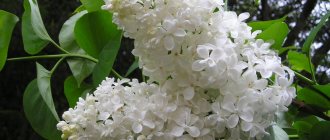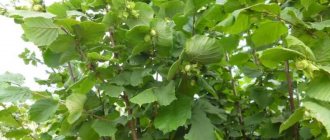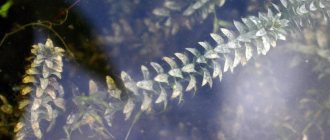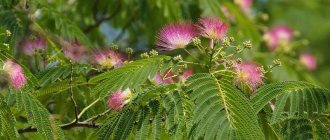Lush lilac inflorescences are the main decoration of our gardens. It is generally accepted that its flowers are white and lilac, but thanks to selection, the lilac palette has been replenished with pink, blue, purple and even yellow. It is quite undemanding, resistant to urban environments and frost, prefers moderately humid, well-lit areas protected from the wind.
History of the name
became known to the Slavic people in the 14th century, and was first brought from Turkish lands. The history of the origin of the pleasantly smelling shrub is quite interesting and shrouded in many legends.
One of them says that lilac got its name from the ancient Greek goddess Syringa, who, turning into a flowering bush, escaped from the advances of the god Pan. The voluptuous man had long sought the beauty’s attention, but was constantly refused. Unable to bear another decisive “no,” Pan began to pursue Syringa, and she, in order to somehow preserve her honor, turned into a pleasantly smelling lilac bush.
The second legend says that the beautiful plant is the work of the goddess of Spring. While coloring the waking Earth, the girl was so carried away by her work that there were no colors left in her palette except white and purple. Since there were still unpainted areas on the planet, she mixed the remaining shades and, using a solar ray, brought them down to the ground. At that very moment, where the messenger of Spring touched the soil, beautiful shrubs with small unusual flowers and a delicate aroma sprouted.
From a scientific point of view, the shrub, which belongs to the olive family, currently has more than 35 species of wild representatives, which are scattered in various parts of our planet. Thus, common wild lilac is found not only in Russia and Ukraine, but also in Japan, China, the Balkans, Hungary and Asia.
Care
It is believed that lilac is one of the most unpretentious plants. However, we all understand that everyone needs care without exception.
We want to admire the lush and fragrant color, which means we have to give our attention and care in return. The most important thing in care is regular loosening of the soil.
Especially when the lilac is young. After all, loosening promotes good access of moisture and air to the soil. Lilacs need to be protected from frost in the spring and from drought in the summer.
Watering
This plant needs to be watered in the first half of summer. If the weather during this period is not rainy, watering should be abundant and deep. Approximately up to thirty liters per square meter. In the second half of summer, you can water lilacs in case of severe drought. Excess moisture during this period can lead to re-awakening of the kidneys.
Fertilizer
Proper nutrition is also an important condition for the full growth of lilacs. This plant needs almost all the basic chemical elements
Among them are nitrogen, phosphorus, calcium, sulfur, iron, iodine, fluorine, zinc, and this is not the whole list. The bush needs to be fertilized when it reaches two years of age. Fertilize three times a year. The first fertilizing is done immediately after the snow has melted. The second and third with an interval of twenty days. The ideal material for feeding is humus or rotted manure.
Pests and diseases
Let's take a look at the most common diseases:
- mosaic;
- calcium spot;
- necrosis;
- verticillium wilt;
- late blight
To easily recognize these sores, let's take a look at their description. The mosaic manifests itself in the appearance of small yellow spots on lilac leaves. With severe damage, the leaves curl and the plant eventually dries out. Calcium spot is a viral disease. It is transmitted during cutting and during the grafting process. Appears in the form of various patterns on the leaves. Necrosis is a very common bacterial disease. It appears in the form of wilted leaves and tops of lilacs. Particularly common in cold and wet years.
Verticillium wilt is a fungal disease. In the presence of this disease, leaves turn yellow and wither. The disease is very complex and incurable. Affected bushes are destroyed by burning. Late blight is indicated by dried and blackened buds. Brown spots are visible on the bark and leaves. This disease is treated by spraying with Bordeaux mixture.
Lilac is a symbol of spring with a heady aroma. Represents the awakening of nature after a long sleep. Enjoying its aroma and admiring the lush color, we firmly believe in the beginning of a new and happy stage in our lives. Let it be so and only so.
Plant characteristics
The bush of ordinary wild lilac is a tree-like plant up to 7 m high, with small clusters of star-shaped inflorescences of delicate shades and a delicate aroma. The leaves are usually green, spear-shaped, do not turn black even in winter and fall to the ground in a green color.
It is known that there are up to 18,000 flowers on an ordinary lilac bush. The total weight of the inflorescences is about 9 kilograms. The star-shaped inflorescences of the plant are:
- white;
- lilac;
- pink;
- multi-colored;
- yellow tint.
Everyone knows that if a lilac bush has blossomed nearby, it means that spring has really come and there will be no more frosts. Abundant flowering of shrubs is observed from May to June. The plant is classified according to several characteristics. The main classifiers of lilac are:
- flowering time;
- flower size;
- color of the grapes.
According to the period of active flowering and fragrance, bushes come in three types. Experts divide them into:
- early;
- medium flowering;
- late.
Early plant varieties bloom in the 20th of April and finish flowering in early May. Then comes the turn of the mid-flowering bushes, which delight the eyes of passers-by throughout May. But late lilacs bloom their flower clusters in the last days of May and bloom until the 10th of June.
There is a division of lilac bushes by flowers. According to the generally accepted classification, plants are divided into:
- small-flowered;
- medium color;
- grandiflora.
Small flowers in inflorescences do not exceed 10 millimeters in size. The average flowers on lilac bushes reach 20 millimeters. But large star flowers can be as large as 25 millimeters.
Appearance in Europe
Lilacs came to Europe from Constantinople towards the end of the 16th century. It was brought by the ambassador of the Roman Empire, Ogier, Ghislain de Busbecq. 20 years later, the first lilac bush bloomed in Vienna. However, gardeners of that time were unable to appreciate the flowers.
Only after two centuries did the breeder Victor Lemoine manage to develop ornamental varieties of shrubs with lush inflorescences of various colors.
In Russia, lilacs allegedly appeared during the confrontation with Sweden. After the siege of the sea fortress of Sveaborg on May 20, 1808, Russian troops received 7 thousand prisoners, 2 thousand guns and an island planted with lush lilacs. Since then, this plant began to appear in vast areas of the country.
Types of simple lilac
Simple Syringa bushes also have their own varieties. The most common ones that the common man encounters are:
- Blanche Sweet;
- Mulatto;
- India.
The description of Blanche Sweet lilac is quite ordinary. The bush reaches a height of 4 meters and in spring is covered with pale lilac or whitish-bluish inflorescences. The diameter of flowering stars on such a plant reaches 30 millimeters.
The Mulatto variety is also quite common in our latitudes. The plant received this name because of the color of the flowers, soft pink in the middle and dark burgundy on the outer surface. Tree-like bushes are usually erect and covered with dark green succulent leaves.
Stars of the India variety have a rather rich purple hue and a persistent, clearly perceptible aroma. Plants of this species are quite spreading and also covered with rich green foliage.
Known varieties
varieties are also known in nature . Among them we can especially highlight such shrubs as:
- Hyacinth.
- Broadleaf.
- Hungarian.
- Drooping.
- Persian.
- Himalayan.
- Hairy or shaggy.
- Mayer variety.
Shrubs of the hyacinth species or Syringa hyacinthiflora are very interesting and unusual. By autumn, the foliage of the plant acquires a burgundy color, but the flowers are scattered throughout the bush quite abundantly and have a palette from pale lilac to deep pink. The clusters of stars themselves are quite massive and heavy in appearance.
The broad-leaved plant species, called Syringa oblata in Latin, is usually represented by three-meter-tall bushes with a spreading crown. The foliage of this representative of lilac is shaped like a heart, and the color scheme of the star flowers varies from violet-lilac to pale pink.
At first glance, the inflorescences of the Hungarian lilac, or Syringa josikaea, resemble delicate lace that has somehow magically enveloped the bush. Representatives of this species reach a height of 4 meters, and the color of their stars is a soft pink or lavender hue. It is noteworthy that the bushes have practically no smell.
Syringa reflexa, or Drooping Lilac, is very unusual for the plant bushes familiar to the eye. The uniqueness of this species lies in the shape of the flowers, which are quite oblong and form real drooping or drooping clusters like grapes. The outer side of the tube flowers is usually deep pink, but the inside of the inflorescence is almost colorless.
The foliage of the Persian variety of lilac, or Syringa persica, has a characteristic pointed shape, and the star-shaped flowers are a bright lilac-violet color, with distinct petal separation. Plants of this species have a rather unusual and rich aroma. The height of the bushes does not exceed 3.5 meters.
The Himalayan lilac is quite unusual in appearance. It has long tube-shaped flowers like the drooping species, and their color is always white, without any inclusions. However, nature has worked on the color of the leaves, and their palette includes soft green edges and a dark green center. The aroma of such a bush is also quite unusual for most inhabitants of our planet. The uniqueness of the species also lies in the fact that it can be found at an altitude of more than 1900 meters above sea level.
Shrubs of Syringa villosa, or hairy lilac, do not reach 3 meters in height when mature. The color of the leaves has soft green shades, and the buds are a pleasant pink color, and the inflorescences can reach a length of 24 cm. The homeland of the plant is considered to be the territory of modern China and Korea.
The shrub of the Mayer species is considered the shortest and most miniature in its parameters. This plant, in Latin Syringa meyeri, does not exceed 1.5 meters in height, and the color range of flowering stars varies from light pink to light lilac shades. The foliage of the shrub is rich green in color with clearly visible veins.
Lilac diseases and pests: combating them, treatment, description and photo.
Lilacs are rarely affected by pests and various diseases, but this fragrant beauty also has “health problems.” The most dangerous and common diseases and pests of lilac are the following:
Bacterial (nectria) necrosis of lilac: The disease usually begins to progress in early to mid-August. Signs of garden lilac disease are, first of all, a change in the color of the leaves from green to ash-gray, and young shoots of the bush and branches become brown or brown. Control measures: thinning lilac plantings for optimal ventilation, timely control of insect pests, as well as cutting and burning all damaged parts of the bush or completely removing a heavily infected plant by uprooting.
Powdery mildew on lilac (caused by the fungi Microsphaera syringae, Microsphaera penicillata f. syringae). It quickly affects both young seedlings and adult bushes. The lilac leaves turn white, and a powdery coating of gray-whitish color becomes noticeable on them. The disease occurs especially often during dry and excessively hot summers. Control measures: infected parts of the lilac must be removed and burned. In early spring, you need to add bleach to the soil (100 g per sq.m.) and carefully dig the soil, trying not to disturb the roots of the bush.
Verticillium wilt of lilac. This disease is provoked by the fungus Verticillium albo-atrum; the lilac leaves curl, brown or rusty brown spots appear on them, the leaves dry, wither and fall off. The lilac dries out (usually from the top) and quickly dies. Treatment: treating the bush during the growing season with a solution of soda ash and laundry soap in a ratio of 100 grams (1:1) per 15 liters of water, spraying with Abiga-Peak, as well as burning fallen leaves and damaged growth.
- The lilac leaf mite (lat. Eriophyes saalasi) is a tiny insect with an appetite that sucks the juices from the underside of the leaves, as a result of which the lilac leaves turn brown and dry out. Large populations of the pest can destroy a healthy and large bush in a couple of weeks. Control measures: apply phosphorus-potassium fertilizers to the soil around the tree trunk, prune thickened branches, treat the bushes with copper or iron sulfate, burn the fallen leaves before the onset of winter.
- Lilac bud mite (lat. Eriophyes loewi). The entire life of this pest passes in the buds of the lilac bush, where it feeds on the juices of the plant and overwinters there. As a result, the buds become deformed, weak, underdeveloped leaves and shoots appear from them; as a result, the lilac does not bloom and often dies in the second or third year. Treatment: treatment of the bush with copper sulfate as soon as the frosts have passed (before the buds open), removal of dry leaves and root shoots, autumn digging of the soil around the bush no less than a full bayonet of a shovel with turning over the layers.
- Lilac leaf miner is an insect pest that quickly attacks the leaves of a plant. Initially, lilac leaves are covered with dark brown spots (mines), after a while they curl into a tube, becoming as if burned. Lilac bushes affected by moths stop blooming and die after 1-2 years. Control measures: deep digging of the soil with careful turning of the soil under the bush before frosts and in the spring, pruning the affected leaves and then burning them. An already infected plant must be treated with Bordeaux mixture, Baktofit or Fitosporin-M, spraying generously on the foliage.
In any case, pay attention to the planting material: seedlings should have a well-formed root system, glossy buds with tightly fitting scales and healthy green leaves with a smooth matte or slightly glossy surface
Planting a bush
Lilac bushes are relatively unpretentious and quite easy to plant and care for. Experienced breeders and gardeners recommend choosing sunny, draft-free areas for planting. It is also worth considering that bushes of the genus Syringa for the most part do not like very moist soil, with the exception of the Himalayan species, which likes to grow near water bodies.
If you plan to plant two or more shrubs, then it is worth leaving a distance between them of 1.5-2 meters for normal plant development. It is also worth considering that the planting time for different varieties of Syringa is also different, and it is better to consult with specialists about this.
Traditional medicine attributes to the plant not only aesthetic, but also healing powers. Since ancient times, tinctures of lilac leaves and flowers have been used to treat colds and infectious diseases. Tea from plant inflorescences was also consumed to cleanse the body of possible parasites and viruses. Common lilac leaves have disinfectant and wound-healing properties, just like plantain leaves, known to everyone since childhood.
In spring, the plant pleases the eye and improves mood. It is also known that the aroma of lilac helps relieve nervous tension and promote good sleep.
Unsuitable soil
Common lilac.
growing common lilac. caring for common lilac It should be remembered that each variety of lilac grows only in a certain soil, since breeders grow unique varieties in greenhouse conditions, giving them various fertilizers. And then it turns out that they cannot grow and bloom in ordinary soil, unlike ordinary varieties, which do not care what the composition of the soil is.
Then the likelihood that the lilac will bloom will increase.
If the soil is waterlogged and swampy, then it will be difficult for lilac to grow in it, since it is not a moisture-loving shrub.
And heavy clay soil will not suit it, since the roots will not be able to receive enough oxygen. The same can be said for acidic soil.
For ideal development of the shrub, the soil must have neutral acidity and moderate moisture. If the lilac is planted in an area that is too windy, then there is a high probability that it will not bloom, since it will feel very uncomfortable in this place.











